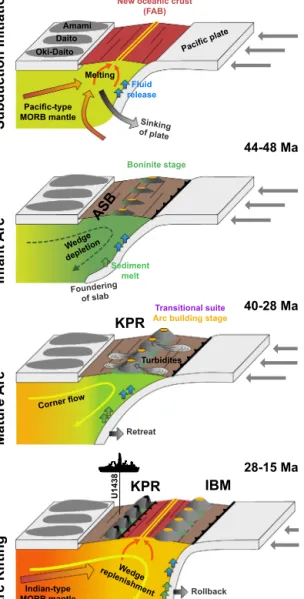Contents lists available atScienceDirect
Earth and Planetary Science Letters
www.elsevier.com/locate/epsl
The arc arises: The links between volcanic output, arc evolution and melt composition
Philipp A. Brandl
a,b,∗, Morihisa Hamada
c,d, Richard J. Arculus
b, Kyle Johnson
e, Kathleen M. Marsaglia
e, Ivan P. Savov
f, Osamu Ishizuka
d,g, He Li
haGEOMARHelmholtzCentreforOceanResearchKiel,Wischhofstr.1-3,24148Kiel,Germany
bResearchSchoolofEarthSciences,TheAustralianNationalUniversity,142MillsRoad,ActonACT2601,Australia
cDepartmentofSolidEarthGeochemistry,JapanAgencyforMarine–EarthScienceandTechnology,2-15Natsushima-cho,Yokosuka237-0061,Japan dResearchandDevelopmentCenterforOceanDrillingScience,JapanAgencyforMarine–EarthScienceandTechnology,2-15Natsushima-cho,Yokosuka 237-0061,Japan
eDepartmentofGeologicalSciences,CaliforniaStateUniversityNorthridge,18111NordhoffStreet,Northridge,CA91330-8266,USA fSchoolofEarthandEnvironment,TheUniversityofLeeds,InstituteofGeophysicsandTectonics,LeedsLS29JT,UnitedKingdom gGeologicalSurveyofJapan/AIST,Central71-1-1Higashi,Tsukuba,Ibaraki305-8567,Japan
hGuangzhouInstituteofGeochemistry,ChineseAcademyofSciences,511KehuaStreet,WushanGuangzhou510640,China
a r t i c l e i n f o a b s t ra c t
Articlehistory:
Received4November2016
Receivedinrevisedform18December2016 Accepted19December2016
Availableonlinexxxx Editor:T.A.Mather
Keywords:
Izu–Bonin U1438 mantlewedge subduction islandarc meltinclusion
Subductioninitiationisakeyprocessforglobalplatetectonics.Individuallithologiesdevelopedduring subductioninitiationandarcinceptionhavebeenidentifiedinthetrenchwalloftheIzu–Bonin–Mariana (IBM)islandarc butacontinuousrecordofthisprocess hasnot previouslybeendescribed.Here, we present results from InternationalOcean DiscoveryProgram Expedition 351that drilled asingle site westoftheKyushu–PalauRidge(KPR),achainofextinctstratovolcanoesthatrepresentstheproto-IBM islandarc, activefor ∼25 Ma followingsubduction initiation.Site U1438recovered150mofoceanic igneousbasementand∼1450 mofoverlyingsediments.Thelower1300 mofthesesedimentscomprise volcaniclasticgravity-flowdepositsshedfromtheevolvingKPRarcfront.Weseparatedfreshmagmatic minerals from Site U1438 sediments, and analyzed 304 glass (formerly melt) inclusions, hosted by clinopyroxeneandplagioclase.
Compositions of glass inclusions preserve a temporal magmatic record of the juvenile island arc, complementary to the predominant mid-Miocene to recent activity determined from tephra layers recoveredbydrillingintheIBMforearc.The glassinclusionsrecordtheprogressive transitionofmelt compositionsdominatedbyanearly‘calc-alkalic’,high-Mgandesiticstagetoayoungertholeiiticstage over a time period of 11 Ma. High-precision trace element analytical data record a simultaneously increasing influence of a deep subduction component (e.g., increase in Th vs. Nb, light rare earth elementenrichment)andamorefertilemantlesource(reflectedinincreasedhighfieldstrengthelement abundances). Thiscompositional changeisaccompaniedbyincreaseddepositionratesofvolcaniclastic sedimentsreflectingmagmaticoutputandmaturityofthearc.Weconcludethe‘calc-alkalic’stageofarc evolutionmayendureaslongasmantlewedgesourcesarenotmostlyadvectedawayfromthezonesof arcmagmageneration,ortherateofwedgereplenishmentbycornerflowdoesnotoverwhelmtherate ofmagmaextraction.
©2017TheAuthors.PublishedbyElsevierB.V.ThisisanopenaccessarticleundertheCCBYlicense (http://creativecommons.org/licenses/by/4.0/).
1. Introduction
Subduction initiation andaccompanying onset ofarc magma- tism are criticalprocesses inglobalplatetectonics. However, the precisetemporal,spatial,andcompositionalevolutionof theearly
*
Correspondingauthorat:GEOMARHelmholtzCentreforOceanResearchKiel, Wischhofstr.1-3,24148Kiel,Germany.E-mailaddress:pbrandl@geomar.de(P.A. Brandl).
stagesofislandarcmagmatismarepoorlyunderstoodeventhough they playamajor roleinthegeneration ofnewcontinentalcrust (DavidsonandArculus,2005).Thefirstmagmaticproductsrelated to subduction initiation inthe Izu–Bonin–Mariana (IBM) subduc- tionsystem(Fig. 1)are52–48 Mabasaltsexposedonthearc-ward trenchwallandhaveaccordinglybeentermedforearcbasalts(FAB) (e.g., Ishizuka et al., 2011a; Reagan et al., 2010). A FAB-like ig- neousbasementofsimilaragewaspenetratedinareararcposition atInternationalOceanDiscoveryProgram(IODP) SiteU1438; this http://dx.doi.org/10.1016/j.epsl.2016.12.027
0012-821X/©2017TheAuthors.PublishedbyElsevierB.V.ThisisanopenaccessarticleundertheCCBYlicense(http://creativecommons.org/licenses/by/4.0/).
Fig. 1.Bathymetricmap withkeygeologicalfeatures ofthenorthern Izu–Bonin–
MarianasubductionsystemandlocationsofSitesU1438(IODPExpedition351)and 1201(ODPExpedition195).ASB:AmamiSankakuBasin.Greydotscorrespondto drilled/dredgedsamplesoftheKPRwithagedata(Ishizukaetal.,2011b),whitedots representIzu–BonintephrasamplesrecoveredfromODPSites782,784,786–788, 790–793andyellowdotsrepresentMarianaarctephrarecoveredfromDSDPSites 53and54andODPSites448,449,451,453,458,459.(Forinterpretationoftheref- erencestocolorinthisfigurelegend,thereaderisreferredtothewebversionof thisarticle.)
magma type was clearly extensively distributed both along- and across-strikeoftheproto-IBMarc(Arculusetal.,2015a,2016).The bathymetry,crustalstructure,andpre-IBMsedimentsinbasinsbe- tween the Mesozoic–Lower Cenozoic arc ridges (Amami Plateau, DaitoandOki-Daito)westofSiteU1438shownosignofcompres- sional uplift and sediment shedding, consistent with subsidence andextensionalriftingaccompanyingaspontaneousmodeofsub- duction inception for the IBM system (Leng and Gurnis, 2015;
Arculusetal.,2016).
Thetimingofsubduction initiationhasbeendatedat∼52 Ma (e.g., Ishizukaet al., 2006, 2011a). Subsequent formation of new oceanic igneous crust (submarine lava flows, sheeted dyke com- plex andplutonicgabbros)withaFAB-like geochemicalsignature lasted for2–4 Ma. In the arc-wardtrench wall of the Izu–Bonin (Ishizukaetal.,2011a) andMarianatrenches(Reaganetal.,2010), FABs are overlainfirst by low-silica boninites andhigh-magnesia andesitesfollowedbyhigh-silicaboninites(e.g.,Pearceetal.,1992;
Kanayamaetal.,2014; Reaganetal., 2015). Thistype ofmagma- tismlastedforabout4 Maandthenfrom44 Maonwards(∼8 Ma after subduction initiation), volcaniclastic sediments indicativeof arcmaturationandvolcanicedifice(i.e.,stratovolcano)buildupand erosionarepreservedintheIBMforearc.
The important phenomena we address in thispaper relate to the post-subduction initiation evolution of the volcanic arc sys- tem,thesubarc mantleandslabsources.We compareourresults fromIODPSiteU1438withcomparablerocksuitesrecoveredfrom other IBMsitesvia dredging ordrilling.Ouraimisto investigate magmatic evolution and provincialism during the early phase of intra-oceanicisland arcvolcanism inthe western Pacific because acorrespondingdetailedrecordofvolcanicarcproducts hasbeen recoveredneitherfromtheKyushu–PalauRidge(KPR)northeac- tiveIBMislandarc.Infact,geologicrecordsofthejuvenilearcare sparseandpreviously restrictedtosettings inthepresentforearc
Fig. 2.OverviewofthedrilledsequenceatSiteU1438,samplingintervalsandage constraintsfrompaleomagneticandpaleontologicalonboardstudies(Arculusetal., 2015b) plottedversusdepth(inmetersbelowseafloor).Ourpreferredageversus depthmodelisshownbyablacklineandthelimitsofuncertaintyinthelower part ofthe sequence areillustrated byared (maximum) and blue(minimum) dashedline.Notethatinthecorerecoverycolumn,whiteintervalsrepresentgaps incorerecovery,indicatingthattheUnitIIIintervalsampledinthis studyisre- markablycomplete.Notethatthepaleomagneticagesrepresentthedepthofeach geomagneticpolaritytimescalechronandthusdonotincludeuncertainties.(Forin- terpretationofthereferencestocolorinthisfigurelegend,thereaderisreferredto thewebversionofthisarticle.)
(e.g., Ishizukaetal., 2006; Reaganet al.,2008). Thus, Site U1438 (Fig. 1)intheAmamiSankakuBasinrepresentsprobablythebest andmostcomplete recordof islandarcevolution beginningwith subductioninitiationintheEarlyEocenetoarcriftingandbackarc openingintheLateOligoceneandEarlyMiocene.
Furthermore,thevolcaniclasticrecordatSite U1438providesa more complete and also ‘averaged’ record of the magmatic evo- lution ofisland arcsthan individual lavaflows (Gill etal., 1994).
Widelydisseminatedashpreservesthebest‘averaged’recordofis- landarcevolutionbutishighlybiasedtoexplosive volcanismand thusthehighlyevolvedendofmeltcompositionsandlackspatial information.Turbidites, incontrast,can belinked tosome degree via seismic stratigraphy(e.g., thickening ofdepositional units to- wardsvolcanicedifices)andtheirrapidtransportandburialmini- mizeschemicalalterationpriortodeposition(Gilletal.,1994).Our studyfocusesonglassinclusionshostedinfreshclinopyroxeneand minorplagioclasecrystalsthatspanadepositionalagefrom29to 40 Ma (Fig. 2). This 11 Ma long record of early arc magmatism sourced fromthe proto-IBM(KPR)is akey to furtherour under- standing ofisland arc evolution andmass transfer insubduction zones.
Fig. 3.RepresentativeBSEimagesofglassinclusionshostedinclinopyroxene.A)Severalglassinclusionswithvariableshapesinaclinopyroxene(U1438E-13R-CC,31–34 cm).
B)Pristineglassinclusion(U1438E-13R-2W,82–85 cm).C)Pristineglassinclusionwithcoolingcracks(U1438E-34R-4W,93–95 cm).D)Pristineglassinclusionwithahighly irregularshape(U1438E-27R-5W,55–58cm).E)Glassinclusionwithalargeshrinkagebubbleandrimspossiblyalteredbypost-entrapmentprocesses(U1438E-34R-4W, 93–95 cm).F)Fullycrystallizedandaltered(formerglass)inclusion(U1438E-13R-2W,82–85 cm).NotethatLA-ICPMSspotsinA)andE)arefromrecenttraceelement analysesandarefortargetingpurposeonly(singleshot).
2. Materialandmethods
2.1.IODPExpedition351Izu–Bonin–Marianaarcorigins
IODPExpedition351aimed to recovermaterial relatedto the inceptionofthe Izu–Bonin–Mariana (IBM)island arcin theEarly Eoceneby drilling asingle siteintothe sedimentsandthebase- ment of the Amami Sankaku Basin (Fig. 1). The expedition suc- cessfully drilled >1,450 m of hemipelagic (Unit I) and volcani- clastic(UnitsII–IV)sedimentsoverlying150 mofoceanicigneous basement(Unit 1;Fig. 2).Theigneousbasementisinterpreted as havingformedduring subduction initiation(Arculusetal.,2015a, 2015b), andthe overlyingsedimentary unitsthickentowards and were likely sourced from the KPR (remnants of the proto-IBM arc)whichboundstheAmamiSankaku Basintothe east(Fig. 1).
The igneous basement provides direct information on the pro- cess and dynamics of subduction initiation; it is overlain by a
∼100 m thick unit (Unit IV) ofdeep-sea mudstones intercalated withvolcaniclasticgravity-flowdeposits(Arculusetal.,2015b) and volumetrically minor intrusive rocks. This sequence we propose reflects the onset of island arc volcanism driven by slow edi- fice growthandvia gravity flow-drivendeposition of pyroclastic- rich materials. Preliminary age constraints on Unit IV are insuf- ficient to precisely date the earliest volcaniclastic deposits but probably overlaps to some extent the episode of boninitic vol- canism preservedinthe IBM forearc (e.g., Ishizukaet al., 2011a;
Reaganetal.,2010).
Overlying Unit IV is a 1,184 m thick sequence (Units II+III;
Fig. 2) of mainly volcaniclastic gravity-flow deposits (Arculus et al., 2015b) that accumulated during the active phase of volcan- ism along the KPR. Volcanism at the KPR prevailed for ∼18 Ma (Ishizukaetal., 2011b) followingsubduction initiationandceased when intra-arc rifting split the KPR and spreading began in the ShikokuandPareceVelaBasin(SPVB) at∼25 Ma (Ishizukaetal., 2011b; Fig. 2). The timeframe of active magmatism at the KPR (Ishizuka et al., 2011b) corresponds very well with observations from IODP Expedition 351 in terms of paleomagnetic and bios- tratigraphic age determinations and type of recovered sediments (Arculus et al., 2015a, 2015b; Fig. 2). In total, we sampled 56 coarse-grained (minimum grain size: medium sand) intervals in UnitIIItoconstructacompleterecordofvolcanismalongtheKPR (29.29–40.25 Ma;Fig. 2).
Shipboard analysisof theSite U1438 corescompleted a com- prehensive mineralogical, lithological and structural description (Arculusetal., 2015b).Post-expedition research has definedsed- imentaryfaciesandincludes interpretations ofsedimentarydepo- sitional processes (Johnson, 2016). These results are summarized insupplementaryTable S1.Biostratigraphicandpaleomagneticda- tums are abundant throughout Units I–II and the upper half of Unit III, allowing us to determine the precise ages of sediment deposition∼850mbsfbutrequiringsome extrapolationfrom850 mbsftothebasement(Fig. 2;supplementaryinformation).
2.2. Glassinclusionanalyses
Volcaniclastic sediments were disintegrated using SELFRAG® high-voltage pulse power fragmentation at JAMSTEC. The major- ity of minerals are clinopyroxene (cpx) with minor plagioclase (plag), quartz, amphibole, andpigeonite. No olivine is preserved.
VisualassessmentofthemineralseparatesandalsoshipboardXRD analyses (Arculusetal., 2015b) indicate an increasing proportion of quartz with stratigraphicyounging (i.e. <1050 mbsf). Individ- ual crystals were mounted in epoxy and especially notable are theabundantglassinclusionspreservedinclinopyroxene(Fig. 3A) that can be exposed at surface by handpolishing. Mostof these glassinclusionsareroundinshapeandpristine(Fig. 3B,C).Inclu- sionswithirregularorangularshape(Fig. 3D)orthoseexhibiting shrinkagebubbles (Fig. 3E)were carefullyexamined andrejected if post-entrapment alteration (e.g., crystallization of the trapped melt;Fig. 3F)wasobserved(seealsoFig. S1).
Major element compositions of glass inclusions and min- eral hosts were obtained using well established electron micro- probe techniques at the GeoZentrum Nordbayern (FAU Erlangen- Nürnberg), the Research School of Earth Sciences (RSES, ANU Canberra) and JAMSTEC. At the GeoZentrum Nordbayern, major element analyses were performedusing a JEOL JXA-8200 Super- probe following standard techniques (15 kV acceleration voltage, 15 nAbeamcurrentand10 μmbeamdiameterforglasses,3 μm forsilicates).Sulfurcontents ofthecorrespondingglassinclusions have beendetermined atRSES usinga peak scan method to ac- countforpossibleshiftsintheredox-dependentK
α
peakposition.At both facilities, the Smithsonian Institute standard glass VG-2 was continuously monitored. At JAMSTEC, major element anal- yses were performed under the same conditions using a JEOL
Fig. 4.A)Totalalkalis(Na2O+K2O)versusSiO2 diagramafterLeBasetal. (1986).B)TiO2versusMgO.Notethegreatdifferenceintheshapeofthedifferentiationtrends betweenthedistinctrockseriesandthetwogroups<37and>37 Mainparticular.C)FeOT/MgOversusSiO2.Low-Fe,medium-Feandhigh-FeassociationafterArculus (2003)andtholeiitic-‘calc-alkalic’divideafterMiyashiro (1974).D)K2OversusSiO2diagramafterLeMaitreetal. (1998).Alldatavolatile-freeandnormalizedtoatotal of100wt.%.Datasources:BoniniteSeriesfromtheBoninRidge:Kanayamaetal. (2012);FAB1201:ODPSite1201:Savovetal. (2006)(alteredsamplesexcluded);FAB U1438:IODPSiteU1438:Arculusetal. (2015a);BoninRidgeIA:high-Mg/islandarctholeiitic/‘calc-alkalic’andesites:Ishizukaetal. (2006);MarianaAFGI(olivine-hosted glassinclusionsfromthemodernMarianaArcFront):Brounceetal. (2014).
JXF-8500Felectron microprobe.Analyticalresultsweremonitored insitubycomparingwiththeanalyticalresultsofMPI-DINGrefer- enceglasses(Jochumetal.,2000).
Trace element analyses were performed at RSES using the newly installed Coherent CompexPro 110 laser ablation system connectedonlinetoan Agilent7700quadrupoleICPMS.A 28 μm spotsize wasusedinallanalyses(40 sablationtime)withCa as aninternal standard,NISTglass610fordriftcorrection andstan- dardglassesNIST-612andBCR-2Gasexternalreferencematerials.
Results from geochemical analyses of all samples and reference materials are presented in supplementary Table S2. See also the supplementaryinformationforfurtherdetails(e.g.,glassinclusion EMPprofiles,Fig. S2).
3. Results
No glass inclusionswithvisible reaction rimsor a microcrys- tallinematrixwereanalyzed,resultingin326glassanalyses from inclusionsvaryinginsize from25to153 μm.The majority(295) are hosted in clinopyroxene (cpx) with mainly augitic and mi- nordiopsidicmineralcompositions(Table S2).Thesehostcrystals range in Mg# from 91.6 to 68.4 (Table S2; Fig. S3) andin TiO2 from0to0.8wt.% (Fig. S4).Another31glassinclusionsarehosted inplagioclaseofvariableanorthitecontent(93.5to42.6)butthese feldsparsarerestrictedtotheintervalbetween350and500 mbsf.
Glass inclusionsthat yielded major element totals of 90wt.%
orlesshavebeenrejectedfromourdataset.Furthermore,thepar-
titioning oftheFe–Mgexchange betweenglassinclusionandcpx hostcrystal(0.27±0.03;Putirka,2008;Fig. S3)hasbeenusedas a criterion to exclude a few erratic inclusions withunusual low Mg#s with respect totheir cpxhost. Based on these criteria, 22 out of the 326glass inclusions analyzed were rejected from the final dataset. Eventhough, post-entrapmentalteration cannot be completely ruledout, compositionalsimilarityofplagioclase- and cpx-hosted glassinclusionsover therespectiveintervalisanother independentmeasureofthepost-entrapment,compositionalinert- nessoftheinclusionsandrobustnessofouranalyticaldata.
Analyses of the remaining 304 glass inclusions show a wide rangeofmagmaticdifferentiationfrombasalttorhyolite (Fig. 4A).
Glass inclusionsare well correlated in TiO2 withtheir respective cpxhosts (Fig. S4). Theseinclusionsshow a broadtrend towards more differentiated compositions (i.e., lower Mg#) with strati- graphic younging (Fig. S5) andtrapped meltswithMgO contents as high as 8.75 wt.% (Fig. S6). Furthermore, the wide range of major oxide compositions when compared at similar indices of magmatic differentiationis remarkable: TiO2, forexample,varies from <0.4 to 1.6 wt.% between 5.0 to 6.0 wt.% MgO (Fig. 4B).
Based on their major element composition, two glass inclusions from coreU1438-27R-5W (∼1096 mbsf) fall just inside thefield ofboninitesasdefinedbyLeBas(2000;Fig. 4A).Theseinclusions have FeOT/MgO of <1.2and MgO >8.0wt.% and thus represent the mostprimitiveend-member ofthelow-Fe (Arculus, 2003) or
‘calc-alkalic’trendamongsttheglassinclusionpopulation(Fig. 4C).
MostoftheglassinclusionssampledfromthelowerpartofUnitIII
Fig. 5.A)Vvs.Ti,B) Yvs.ZrasusedbyArculusetal. (2015a)todiscriminate betweenthedifferentrocksuites.Datasources:Exp.352BoninitesandFAB:Reagan etal. (2015);MORB:JennerandO’Neill (2012),filteredforMORorigin;Otherdata sourcesasinFig. 3.
(>1000 mbsforolderthan37 Ma)havelowertotalalkalicontents (K2O+Na2O;i.e., low-Kassociation)whencomparedtoinclusions shallowerinthesequence(Figs. 4A,D)andbelongtothelow- and medium-Fetrends (Fig. 4C). In contrast,inclusions fromsamples collected fromtheupperUnitIII (<1000 mbsf andyounger than 37 Ma) tend to havelower SiO2 and highertotal alkali contents (Fig. 4A),belongtothemedium- andhigh-Fetrends(i.e.,tholeiite series;Fig. 4C)andarepartofthemedium-Kassociation(Fig. 4D).
‘Classic’HarkerplotscanbefoundinFig. S6.
Althoughthereiscompositionaloverlap,traceelementanalyses of58representativeglassinclusionsreveal somepersistentdiffer- encesbetweenthe<37and>37 Magroups. PlotsofVvs. Tiand Yvs.Zrareusedtodiscriminatebetweenboninites,forearcbasalts and mid-ocean ridge basalts (Fig. 5; e.g., Arculus et al., 2015a;
Reagan et al., 2015; Shervais, 1982). Here, most of the group
>37 Mashowsasimilartrajectorytoboninites(V/Ti:∼10,Fig. 5A;
Y/Zr: ∼2,Fig. 5B) butoffsettoslightlyhigher incompatible trace elementconcentrations(Fig. 5).Thegroup <37 Mashowsawide rangeof compositions andis more similar to the MORB field in Y vs. Zr (Fig. 5B). Furthermore, chondrite-normalized rare-earth element (REE) patterns (Fig. 6A) are flat in the group >37 Ma.
Patternsofthe group<37 Maaregenerallyoffsettohighercon- centrations but also skewedas a resultof light REE enrichment relativetothe heavyREE(Fig. 6A).Thesedifferencesarealsoob- vious using the REE pattern shape coefficients of O’Neill (2016;
Fig. 6B). The group >37 Mapreferably plots towardsthe bottom
Fig. 6.A)CI-normalizedrareearthelementpatternforclinopyroxene-hostedglass inclusions ofSite U1438. Chondritenormalizing values ofMcDonoughand Sun (1995).B)REEpatternshapecoefficientsλ2vs.λ1(O’Neill,2016).Notetheover- alldiversityofU1438datarelativetoglobalMORB(dataasinFig. 4).High-Mg andesiteandislandarctholeiitic/‘calc-alkalic’andesitesofIshizukaetal. (2006)and somerepresentativepatternsforFAB(Reaganetal.,2010) andBoninite(Lietal., 2013) areshownforcomparison.
left-hand cornerofthediagram (strongly depletedLREE; concave downward)andthegroup <37 Ma towardstheupperright-hand corner(enrichedinLREE,concaveupwards;Fig. 6B).
Significant differencesbetweenthesetwogroupsare alsoevi- dent fromtrace elements that, according to Pearceet al. (2005), arecontrolledbyshallowsubduction(i.e.fluids,e.g.Ba),deepsub- duction(i.e.sediments,e.g.Th)orasthenospherefertility(e.g.,Nb).
Thebehavioroftheseelements(andrelativetoYbasaconserva- tive heavy REE) ispresented inFig. 7: mostofthe samplesfrom thegroup>37 MahavesteepertrajectoriesinBavs. Nb(Fig. 7A) comparedtothegroup<37 MabutsimilarThvs.Nb(Fig. 7B).
Results fromsedimentary facies analysesof volcaniclasticma- terialatSite U1438 (e.g.,Johnson,2016) aresummarized insup- plementary Table S1. With the exception of some primary tuff layers, the sedimentary succession comprising Units II and III at Site U1438 consists of silty to sandy to gravel-bearing gravity- flowdeposits,rangingfromturbidites todebrites.Theseflowswere likelysourced nearvolcanicedifices intheKPR,andtraveled10s ofkm beyondproximal volcanic apronfacies asdescribed inthe literature(e.g.,HoughtonandLandis,1989;Allenetal.,2007).De- positionatSiteU1438formeda seriesofatleast12stacked lobe systemsduring4individualepisodes,eachlasting1.6–2.0 Maand separated by phases of relative quiescence (Johnson, 2016). Sed- imentation rates were calculated foreach individual facies-based division(Table S1;Johnson,2016)andshowamajorspikeinsedi- mentaccumulationyoungerthan37.75 Ma(or<1202.7 mbsf).De-
Fig. 7.A)BaandB)Thvs.Nb.C)Ba,D)ThandE)Nbvs.Yb.Datasources:FAB:Ishizukaetal. (2011a);Boninite(Lietal.,2013);BoninRidge:Ishizukaetal. (2006);
Olivine-hostedglassinclusionsfromtheMarianaarcfront:Brounceetal. (2014);Olivine-hostedglassinclusionsfromtheIzuarcfrontandreararc:Nicholsetal. (2012).
Detailsoftheclinopyroxenefractionalcrystallizationmodelcanbefoundinthesupplementaryinformation.NumbersindicateVol.%ofcrystallizationwith“0”markingthe startingcompositionchosenforillustrationpurposeoftheFCtrendonly.
positionratesremainedconstantlyhigh(generally>>50 m Ma−1) until28 Ma(237.9 mbsf),beforetheinputofvolcaniclasticgravity- flowsceasedandsedimentationbecamehemipelagicwithaccumu- lationratesof<10 m Ma−1 (Table S1).
4. Discussion
4.1. Ageconstraintsanddepositionhistory
Precise constraints on relative and absolute ages and the de- position mechanisms of the volcaniclastic sediments are crucial fortheinterpretationofthechemicalcomposition andtheevolu- tionofislandarcmagmatismthroughtime.Depositionalageshave been constrained through paleomagnetic and micropaleontologi- cal data(Arculusetal., 2015b) and correlatewell withpublished 40Ar/39Arages for theKPR. Ishizukaet al. (2011b)dated the ac- tivephaseoftheKPR(overits2600 kmstrikelength)tothetime between48and25 Ma.However,mostexposedvolcanismislim- itedtothefinal phaseof25–28 Mathat isrecordedby thesharp
decreaseindepositionrateatSite U1438(Fig. 2).Theoldest sedi- mentaryagesatSiteU1438(Fig. 2)arelikelytobeolderthanthe 48 MareportedfortheonsetofvolcanismattheKPR(Ishizukaet al.,2011b).
However, acarefulconsideration oftransportmechanismsand deposition environment is required for the interpretation of the geologicrecordofSiteU1438.Firstofall,stratigraphicinformation at Site U1438 from900 mbsf depth andfurther downis limited and requires some extrapolation (Fig. 2, supplementary informa- tion).Inreality,ifgravityfloweventshaveaconsistentfrequency, then intervalswiththick eventsshouldhavehigheraccumulation rates (e.g., Cores 7R-13R and 21R-29R in Hole U1438E, whereas intervals ofthinner units(e.g.,Cores 4R-6R and45R-54R inHole U1438E) should have lower accumulation rates. Ages would be slightly overestimated in the former and underestimated in the latter.Eventhough theabsoluteratesofdepositionarehighlyde- pendent ontheprecise slopeof theage-depthcurve, thegeneral pattern is consistent through all models and is thus considered to be robust (see Table S1 and supplementary information). All
models consistently record two peaks in deposition rate, one at around36–38 Ma andthe secondataround 30 Ma,withdeposi- tionratessignificantly higherthroughoutallofUnitIII compared totheunder- andoverlyingunits.
Proximalvolcaniclasticdepositscanbeaffectedbysedimentre- distributioninconsequence ofseafloorsediment failure triggered by flank collapses(e.g., Lebasetal., 2011; Wattet al., 2012) but noimbricated,raftedorremnant blocksor chaoticdeposits were observedintheseismicprofiles atSite U1438(see Arculusetal., 2015b).Thelackofseismicallydefinedchaoticdepositsisnotsur- prisinginthat thesiteis>50 kmaway fromthearcaxis,where such units might be represented by thin slump-generated tur- biditesordebrites.Thesequence drilledatU1438formed mainly by downslope remobilizationof volcaniclasticarcapron deposits, perhapstriggered by over-steepening ofslopes on thesubmarine arcvolcanicfront,volcaniceruptions,seismicevents,orsomecom- binationofthe above.Furthermore,the 1.6–2.0 Maperiodicityin thevolcaniclastic sequenceat U1438reported by Johnson (2016) correspondswell withthe lifespanof individual volcanicsystems reportedfrom other magmaticarcs including theTaupo Volcanic Zone(>1.6 Ma;Wilsonetal.,1995)ortheLesserAntilles(e.g.,Sil- verHillsonMontserrat:1.4 Ma;Harfordetal.,2002).Eachepisode maythusrepresentadistinctvolcanicsystemwithrecurrencein- tervals of individual sector collapses typically on the order of a few10stoseveral100skaasafunctionoftectonicactivityand/or magma production rate(Samper etal., 2008). Offshore Montser- rat,enhanced ratesofvolcaniclastic deposition(380–790 m Ma−1 proximaland∼530 m Ma−1 moredistal) are directlylinked with volcanicedificematurity(Wattetal.,2012).Site U1438isproba- blymore distal than therecords fromMontserratbut deposition ratesare inasimilar range(generally 50–150 m Ma−1) andpeak at480 m Ma−1 (Table S1;Johnson, 2016). We conclude that Site U1438represents a uniquerecord of atleastfour individual vol- canic episodes of active island arc magmatism along the nearby KPR.
4.2.TheglassinclusionrecordofSiteU1438
Glass inclusions can provide detailed insights into magmatic systemssincetheyrepresentdistinctmagmabatchestrappeddur- ing melt ascentfrom themantle sourceregion to thesurface. In this respect, olivine and spinel are the preferred minerals since theyarethefirstphasestocrystallizeandassuchpotentiallytrap the mostprimitive melt compositions. However, olivine is prone to alteration through seawater and high-pH porefluids (Oelkers, 1999) and spinel is possibly too dense to be transported over largedistances inturbiditycurrents. Asa result, clinopyroxeneis themostcommonmineralphaseinthesampledintervalsofSite U1438andhostsa largenumberofglassinclusions.Asdescribed before, we used a number of criteriato ensure that our dataset is not biased through post-entrapment equilibration and bound- ary crystallization and a thorough discussion is provided in the supplementaryinformation.However,thedifferencesbetweenthe distinctgroupsandthetemporaltrendsoftheinternallyconsistent datasetpresented hereare resistant tomodifying processes.Sys- tematicchanges insizeorshapeoftheglassinclusionthat could resultfromanon-randomoccurrenceofthesealterationprocesses havenotbeenobserved.Furthermore,anumberoftraceelements (i.e.themediumtoheavy REEandY)havesimilarpartition coef- ficientsbetweenmelt andclinopyroxene(e.g.,Greenetal., 2000) andthus thinreactionboundariesobservedatsome oftheinclu- sions (Fig. 3) are not sufficient to significantly fractionate these elementsbetweeninclusionandhost.
TheU1438 glassinclusionsrecord a wide rangeof meltcom- positionfrombasalttorhyolite withdifferentevolutionarytrends (‘calc-alkalic’vs. tholeiitic; Fig. 4). These differing magma trends
are clearer when the data are split into two groups according to their deposition age.The older (>37 Ma) group is composed mainly of(‘calc-alkalic’) high-Mg andesites. Theflat shape ofthe REE patternscloselyresembles that ofthe high-Mgandesites re- coveredfromtheBoninRidgeintheIBMforearc (Fig. 6; Ishizuka et al., 2006). These high-Mg andesites are likely of primary ori- gin(asopposedtoproductsofmagmamixing,e.g.,atMt.Shasta;
Streck et al., 2007) as indicated for example by their low Sr/Y, mantle-derivedorigin(glassMg#sof65–70andcorrespondingcpx hostMg#sof89–92arecommon)andcontinuousmelt evolution.
In contrast to these high-Mg andesitic melts, younger inclusions withdepositionages<37 Maaremainlyarctholeiitesandrelated differentiates.TheirREEpatternsaregenerallymoreenriched,es- pecially in the light to medium REE (La to Sm) and resemble the tholeiitic to‘calc-alkalic’ andesite suitefromthe Bonin Ridge (Fig. 6;Ishizukaetal.,2006).
It is notedthat the record ofmelt compositions witha high- Mg andesite composition (i.e. ‘transitional suite’) at Site U1438 is significantly younger than reported fromother sections of the IBM(Ishizukaetal.,2011a).Interestingly,theevolutionfrom‘calc- alkalic’ to tholeiitic rocks observed atSite U1438 contradicts the generally accepted temporal sequence for island arcs developing fromtholeiiticthroughto‘calc-alkalic’rocksandshoshonitic(Jakeš and White, 1972). Furthermore, our data show that ‘calc-alkalic’
rocks persemay not have higher alkalicontents than island arc tholeiites(Figs. 4A,D).
4.3. IslandarcevolutionrecordedatSiteU1438
Accordingtothe modelofIshizukaetal. (2011b),thelocation ofSiteU1438wouldlikelyhavebeeninfluencedsimultaneouslyby arcfrontandreararcvolcanisminitsearlieststages(Eocene),with locally increasing influence of rear arc volcanism younger than 35 Ma and prior to arc rifting at 25 Ma (Oligocene). Nichols et al. (2012)used olivine-hosted glass inclusionsto investigatespa- tialchangesacrossthecurrentlyactivenorthernIzuarc:arcfront magmas (low-Kseries) show thestrongestinfluenceofa shallow subduction component(i.e., fluid)reflected inhigh Ba relativeto Nb,Th orYb (see Pearceetal., 2005). Incontrast,meltserupted withincreasingdistancebehind thearcfront showincreasing in- fluence of a deep subduction component (i.e., sediment melt) in that they havehighThrelative to NborYb, highCe/Pbandele- vatedlightREEandare associatedwiththemedium-Kseries(see Pearceetal., 2005; SkoraandBlundy,2010;Nicholsetal., 2012).
Imprinted onthese‘local’processes,Straub (2003)suggestedthat the ultrarefractory mantlepresentfollowing subduction initiation (i.e. the source of boninite volcanism) is gradually replaced by (morefertile) IndianMORBmantleduringtheEoceneasreflected inhighlyimmobiletraceelementsthataresensitivetothefertility ofthemantlesource(e.g.,Nb/Yb;Pearceetal.,2005).
Inordertoidentifytherelativecontributionsfromthesethree components,wehavecompiled representativedataforFAB,boni- nite,arcfrontandreararcmeltcompositionsfromtheIBMsystem inFig. 6.Amongthesegroups,FABhavethelowestsubductionin- put(i.e., low Ba andThrelative to Yb orNb; Fig. 7A–D)but the mostfertilemantlesource(i.e.highNbrelative toYb,Fig. 7E).At firstglance,the>37 MagroupseemtorecordhigherBarelativeto Nb(Fig. 7A)similar tootherglassinclusionsfromtheactive IBM.
Theyounger(<37 Ma)group,incontrast,recordslowerBarelative toNbsimilartoandesitesfromtheBoninRidge.However,usingTh asatracerforthedeep(i.e.,sediment)subductioncomponent,all datafallalmost onan identicaltrajectoryrelativeto Nb(Fig. 7B).
BycomparingBaandThtoNbonly,wewouldthusconcludethat thegroup >37 Ma was moreinfluencedby ashallowsubduction componentrelative to the <37 Ma group.However, Pearce etal.
(2005) have shownthat abundances of Nbin wedge sources are
variable.Indeed,ifwe compareBa,ThandNbtoYb (anelement thatisindependentfroma“lithosphere”component;Pearceetal., 2005),therelativecontributionsofsubductioncomponentschange significantly.BariumrelativetoYb,forexample,issimilarinboth groups,withsomeinclusionsfromtheoldergrouprecordingeven lower Ba concentrations (ata given Yb)than the <37 Ma group (Fig. 7C).A similarpatternisobservedinThvs.Yb(Fig. 7D),where bothgroupsshowabroadoverlapwiththe>37 Magroupextend- ingtolowerThandthe<37 MatohigherThatagivenYb.
ThesepatternscanbeexplainedbythedifferencesinNbrela- tive to Yb inthe two groups(Fig. 7E). The >37 Ma group tends to have lower Nb at a given Yb than the <37 Ma group (and viceversa)despiteabroadoverlap.Tochangethesetraceelemen- talsystematicssignificantly,post-entrapmentcrystallizationofcpx wouldhave to exceed20 Vol.%(see modelcurves in Fig. 7). We considerthistobe unlikely because:1) cpxboundary crystalliza- tiondoesnotsignificantlyaffectmosttrajectoriesoftheseelemen- talpairs;and2),invocationofdifferentialcpxcrystallizationisan adhocexplanationtoaccountforadifferencebetweentwogroups of an internally consistent dataset (i.e. all U1438 data shown in Fig. 7 are cpx-hosted). To summarize, an increased contribution from a deep subduction component (e.g., Th/Yb) and refertiliza- tion(e.g.,Nb/Yb)ofthemantlewedgeisindicatedwithprogressive
‘life’ofthearc.Thisviewissupportedbytherangeinfluidmobile elementssuchasPborUthatissimilarinbothgroupsbutaccom- paniedby increasingCe orTh(deepsubduction component)with younging(Figs. 8A,B).Infact,overall thelightREEthatare plau- siblycontrolledby thedeepsubduction component(Pearceetal., 2005; SkoraandBlundy,2010) areboth enriched inthe<37 Ma group relative to the medium and heavy REE, and also relative to theoldergroup (Fig. 6). An overall decreasein degree ofpar- tialmeltingthroughtimecouldexplainsomeofthetraceelement variationobserved.However,amorefundamentalgeodynamicpro- cessis requiredto explain all of thepatterns observed including themajorincreaseinTiO2 withtime(Fig. 4B)andtheconcomitant progressivechangefromthe‘calk-alkalic’(low-Fe)tothetholeiitic (medium-Fe) association (Fig. 4C). Some inclusionsyounger than 30 Maindicateanoveralldecreasingslabcontribution(e.g.,lower Ba/La,higherCe/Pb)thatmaybeattributedtoagreaterproportion of decompression melting. Such melts share geochemical signa- turesofboth,arcandbackarcandmayhaveformed inapre-rift phase ofthearc, possibly along smallregions ofupwelling man- tlethat,followingarcriftingandbackarcextension,commonlylink volcaniccenters ofthearcfront andbackarc informofso-called
‘hotfingers’(e.g.,Tamuraetal.,2002).
4.4. Turbochargingthearc
Duringthetimeperiodwhentheproto-IBMarcwasdominated byboninitic melts(evidentfromtheforearc recordas48–44 Ma;
e.g.,Ishizuka etal.,2011a), arc-derivedsediment depositionrates were low (<11 m Ma−1; Table S1)at Site U1438.This mayindi- catethatboniniticmagmatismwasfocusedclosertothetrenchor morerestricted across-strikewithsubdued topographylesslikely togeneratefar-traveledgravityflows.
ThetransitionfromUnitIVintoUnitIII atSiteU1438 reflects asharpincreaseintherateofdeposition(Fig. 2) whichwethink reflectstheonsetofthetopographicallyprominent,stratovolcano- buildingstage ofthe arc. The precise timing of thistransitionis yetto be determinedbutthe time frame(40–46 Ma,mostlikely 44–46 Ma; Fig. 2) isconsistent withthe transitionfromboninitic toarctholeiiticand‘calc-alkalic’lavasacross theIBM(i.e.,transi- tionalsuiteofIshizukaetal.,2011a).However, we haveevidence atSiteU1438foraprolonged(ordelayed)transitionalperiodwith high-Mg andesitic melts dominating over arc tholeiitic melts at least until 37 Ma. The transition from a high-Mg andesitic into
Fig. 8.A)Pbv.Ce,B)Uvs.ThandC)Zrvs.Hf(allinppm).Notethesteepslopesof boninitesandU1438GI(Cpx)>37 MadatainA)andB)thatindicateastronginflu- enceofslabfluids(Pb,U).Withdecreasingage(i.e.,U1438GI(Cpx)<37 Magroup), samples becomeenrichedinCe andTh attributed toanenhancedcontribution fromsediments tothe KPRarcmagmas.Highfield-strengthelementsystematics (C)indicateaprogressiveenrichmentofZrrelativetoHfovertime(mantlewedge replenishment).Regressionshavebeenfittedthroughtheorigin.DataasinFig. 6;
MORB:JennerandO’Neill (2012),filteredforMORorigin.
an arctholeiiticmagmadomainisaccompaniedbyatleastthree- fold increase in deposition rate (Fig. 9) that indicates a signifi- cantincreaseinmagmaproductionrate.Simultaneously,thedeep subduction component (i.e., sediment melt) becomes more pro- nounced and the increase in Nb relative to Yb or Zr (or Zr/Hf;
Fig. 8C)indicates anincreasing fertility ofthe mantlesource.The changeinNb/YborNb/Zrcannotresultfromabiasinthedataset (the <37 Ma group has lower Mg# on average) since no corre- lation between these ratios and SiO2 is observed (Fig. S7). We conclude the change in magma source domains resulting in the transition from high-Mg andesitic (i.e. transitional suite) to arc tholeiitic is driven by a refertilization (or replenishment) of the mantlewedgeaccompaniedbyanincreasedcontributionfromthe deep subduction component. We note that deposition rates de-
Fig. 9.Age[Ma]plottedvs.Nb/Ybanddepositionrate[m Ma−1].Alsoshownare majorrifting/spreadingeventsintheIBMandourinterpretationofthelong-term trendsobservedinNb/Ybreflectingperiodsofdecreased(“depletion”)orenhanced (“replenishment”)wedgecornerflow.DepositionratesforSite1201fromSalisbury etal. (2006)andSiteU1438(seealsoTable S1).DataforIBMTephra(andclast) record:Arculus andBloomfield (1992), Bryantet al. (2003), Savovet al. (2006), Straub (2003),Straubetal.(2004, 2015);IBMTurbiditerecord:Gilletal. (1994);
KPRlava:Ishizukaetal. (2011b);MukojimaGroup(BoninRidge):Kanayamaetal.
(2014);BoniniteSuite:Kanayamaetal. (2012),Lietal. (2013);Marianasarcfront:
Olivine-hostedglassinclusionsfromtheMarianaarcfront:Brounceetal. (2014).
crease only slightly after 36 Ma remaining relatively high at an averageof∼50 m Ma−1(Fig. 9).
Asecond peakindeposition rates(∼145 m Ma−1)between31 and29.5 Ma(Fig. 9) iscoincidentwithinitialarcrifting (Ishizuka etal., 2011b). Consistently,glass inclusions<30 Ma reflecta hy- bridarc-backarcmagmasource(i.e.,Ba/LaandCe/Pbofabout10;
seediscussionabove).Thissecondpeakindepositionratemayre- flectan increase in magmaticactivity (and alsotectonic activity) prior to or during arc rifting and hasalso been observed in the Tonga-Kermadecsubductionsystem(CliftandODPLeg135Scien- tific Party, 1994). There, the magmatic maximum is followed by asharpend toanyvolcaniclasticsediment supply fromtherem- nant part of the island arc once magmatism focuses along the backarc spreading center. Site U1438 records a similar decrease indepositionalrateduringthetimeofmedium-Krear-arcvolcan- ismalongtheKPR(29.3–24.8 Ma;Ishizukaetal.,2011b;∼Unit II;
Figs. 2, 9) before magmatic activity and volcaniclastic sediment supplyceasedwiththeonsetofbackarcspreadingintheShikoku and Parece Vela Basins. As a result, hemipelagic sedimentation dominatestheupperpartofthesequence(UnitI;Figs. 2,9).
The volcanic productivity of the arc as expressed by deposi- tionratesofvolcaniclasticsedimentsisthusdirectlyrelatedtothe average meltcomposition andsource (i.e.mantlewedge)fertility (Fig. 9).
4.5. Possiblecausesformantlewedgereplenishment
Subduction may initiate asa consequence of plate reorienta- tionandsuper-fastslabroll-backbutthefundamentalcausesand mechanismsarestillactivelydebated (LengandGurnis, 2015;Ar- culus et al., 2015a, 2016; Keenan and Encarnación, 2016). Less controversial is the geologic record of subduction initiation that starts withdecompression meltingof a refractory mantlesource accompaniedbytheminoradditionofasubductioncomponentto generate an extensivearea ofnew oceaniccrust with a FABsig- nature(Ishizukaetal.,2011a; Arculusetal.,2015a;Reagan etal., 2010,2015;Fig. 10).Ithastobenotedthoughthatinthelightof
‘FAB’ sampledin forearc andreararcsettings andsome composi- tionalvariability,termanddefinitionof‘forearcbasalt’needtobe reconsidered.
The residual ultra-refractory material in the mantle wedge (∼20%meltdepletionrelativetoafertileMORBmantle;Pearceet al.,1992)then becomesthesourcefortheextractionofboninites due to the addition of large volumes of subduction fluids (e.g., Pearce et al., 1992; Fig. 8), lasting for about 4 Ma (48–44 Ma;
e.g., Ishizuka et al., 2011a, 2006; Fig. 10). A similar scenario of a spreading center capturing early subduction zone magma- tism andfollowed by a change in magmatism from tholeiitic to boninitic hasbeen suggestedforthe Troodos Ophiolite(Regelous et al., 2014). The mantle wedge during arc inception was oc- cupied by material of the Pacific-type MORB domain (Savov et al., 2006; Hickey-Vargas et al., 2006; Straub et al., 2009, 2010, 2015). A ∼3 Ma long period of transitional arc magmatism fol- lowed(high-Mgandesites;e.g.,Ishizukaetal.,2011a,2006)during whichthemantlewedgeofthePacific-typeMORBdomainbecame progressively replaced by mantlewith an Indian-type MORB sig- nature(Straub,2003;Straubetal.,2009,2010,2015).ThisIndian- type MORB signature hasalsobeen recordedfromthePhilippine Sea Plate (e.g., Hickey-Vargas, 1998; Hickey-Vargas et al., 2006;
Straub et al., 2009) and we think that the refertilization/replen- ishmentobservedatSiteU1438islinkedtotheexchangeofthese two mantle domains in the mantle wedge. The ‘delayed’ change we observed (i.e. ∼36–38 Ma) may be attributed to a progres- sivebutratherslowexchangeofmaterial(i.e.no sharpboundary betweenthemantledomains),theprogressionofwedgereplenish- mentalongtheIBMsystemfromtheNorthtotheSouth(Straubet al., 2015), ordiversification of the mantle wedge in response to regionaltectonics(Pearceetal.,2005).
Severalstudies(Straub, 2003; Straubetal., 2015) and alsothe compositionalpatternsobservedatSite U1438(Figs. 7,8)suggest thattheprimarycontrolofIBMarcmagmasisindeedthecompo- sitionofthemantlewedge (externalcontrol)ratherthantheim- pactofsubducted slabassemblages alone(internalcontrol). Over the lifetime of the IBM system, specific events such as episodic backarcformation(Clark etal., 2008) influence themantlewedge composition,whichinturncontrolsaveragemeltcompositionand possiblyalsothearcfrontoutput(Fig. 9).
Oligocene turbidites from the IBM forearc (Gill et al., 1994) addan importantperspectivetothefurtherunderstandingofthis process.Theseturbiditesrecord theaveragecomposition ofmelts produced on the eastward migrating part of the KPR that later forms the modern IBM arc. Bulk rock samples from the oldest turbidites afterarc rifting (∼25 Ma) have the highestNb/Yb but becomemoredepletedwithtime(Fig. 9).Thispatternislesspro- nouncedbutsimilartowhatweobserveaftersubductioninitiation (but without the boninite stage; Fig. 9). The effects of backarc
Fig. 10.SketchofIBMevolutionbasedonearliermodels(e.g.,SternandBloomer, 1992;Ishizukaet al.,2006)andthis study.A dynamic slabcontrolsthemantle wedgefromsubductioninitiationabout50–52 Ma agooverthe infantarcstage (44–48 Ma)andmaturearcstage(28–40 Ma)tocessationofmagmatismatthe KPRduetoriftingandbackarcopening(15–28 Ma).Duringtheinitialstage,sink- ingofthe slab releasesfluids that mixedinto the magmain adecompression melting zoneof relativelyfertile mantle. During the infantarc stage, the local tectonicschangefromextensiontocompression,themantlewedgestagnatesand getsprogressivelymoredepleted.Highfluidfluxdrivesmantlemeltingtoproduce boninites.Founderingoftheslabandretreatofthetrenchenhancewedgecorner flowwiththeresultofwedgereplenishment.Thearcbuilding stagebeginswith theaveragemeltcompositionchangingfromboniniteto‘calc-alkaline’high-Mgan- desite(transitionalsuite)andfinallyarctholeiiteswithastrongshallowanddeep subductioncomponent.Wedgereplenishmentpeakswithtrenchrollback,arcrift- ingandbackarcopeningandresultsindecompressionmeltingintheShikokuand PareceVelaBasinsandtheriseofthemodernIBMarc.
spreading(i.e.enhancedcornerflow/wedgereplenishment)onthe subductionsystemmaythusbe similartothe processofsubduc- tion initiation in terms that large volumes of basaltic melt are extractedfromthemantle(backarc basin basaltandFAB, respec- tively),formingaprogressivelymorerefractorymantlethatserves as the mantle source for ‘calc-alkalic’ melts erupted at the arc front.
Thus, the KPR-IBM subduction system is characterized by a
“non-steady-statearcgeochemicalevolution”(Gilletal.,1994) fol- lowingsubduction initiationintheEarlyEocene, maturingofthe arc and periodic arc rifting (Shikoku-Parece Vela Basin, Mariana Trough;Fig. 10).Thisemphasizestheimportanceofchangesinthe
melt sourceregionlinking toreplenishment ofthemantlewedge bymaterialextractedfromthesubductingslabandinfluxofmore fertilemantlematerial(i.e.,theIndian-typeMORBmantle).Where mantlewedgerejuvenationisincompleteorpartsofthewedgeare being‘trapped’inthemantlewedgecorner(stagnation),boninites could erupt independently of a juvenile arc phase (e.g., Tonga;
Cooperetal.,2010).
4.6. Adynamiccontrol?
Infantarcspreading(i.e.formationofnewoceaniccrustwitha FABsignature)requiresanextensionaltectonicregimeinanoverall convergentenvironment(Lengetal.,2012).Founderingoftheslab andtrenchretreatfavorasthenosphericupwelling,decompression melting and formation ofnew oceanic crust with a geochemical FAB signature (Fig. 10). In subduction systems where ridge push drives constantstress (no trenchmigration)boninitescan stillbe produced butnewoceaniccrustis notbeingformed (Leng etal., 2012). Thus,the sequenceofboninite followingFABis consistent withbothcontrastingmodesofsubductioninitiation(i.e.,induced vs. spontaneous) butnotwitha constantstress regime.However, recent results from IODP Exp. 351 favor (Arculus et al., 2015a, 2016) or are at least consistent with the model of spontaneous subduction initiation (Leng and Gurnis, 2015). Furthermore, the missingfar fieldstress field consistentwithspontaneoussubduc- tioninitiationmaypromoteinfantarcspreading.
Duringarcinfancy,thepreferentialdowndipsinkingoftheslab mayinduceanonly“sluggish”flow inthemantlewedge(Kincaid and Griffiths,2003) thatwould thenenhance the residencetime oftherefractorymantlesourceresidualtoFABextractionandthe sourceforsubsequentboninitemeltextraction(Fig. 10).Thissce- nario would be consistent with further depletion of the mantle source(FABtohigh-Caboninitestolow-Caboninites)asobserved inthe IBMforearcby Pearceetal. (1992).Founderingoftheslab finallyresults intrenchretreat(LengandGurnis,2011;15 mm a−1 intheIBMsystem:SternandBloomer,1992)andinducesastrong mantleflow(KincaidandGriffiths,2003).Theinducedflowinthe mantle wedge may control the progressivereplenishment of the mantlewedgethatleadstothetransitionintheaveragemagmatic outputofthearcfromboninitesto‘calc-alkalic’high-Mgandesites toarctholeiitesobservedatSiteU1438(thisstudy)andelsewhere in the IBM (e.g., Ishizuka et al., 2011a and references therein;
Fig. 10). Increased temperatures as a consequence of higher ve- locitiesofthemantleflow(KincaidandGriffiths,2003) likelyalso promotethe influenceofa deepsubductioncomponent(i.e.,sed- iment melts). The evolution of magmatism in the IBM fromFAB over boninites to ‘normal’ arc magmatism is almost synchronous (Ishizuka etal., 2011a) and thus consistent with a slab-dynamic control.
We suggest the boninite and ‘calc-alkalic’ high-Mg andesite stages of arc evolution may endure as long as mantle wedge sources are not advected away fromzones of arcmagma gener- ation,ortherateofwedgereplenishmentbycornerflowdoesnot overwhelmtherateofmagmaextraction.
5. Conclusions
IODP Expedition 351 Izu–Bonin–Mariana Arc Origins recov- eredauniquesection ofvolcaniclasticsedimentsthat recordsthe full lifespan oftheKyushu–Palau Ridge,the proto-IBMislandarc.
Thesesedimentsweretransportedfromthevolcanicsourcetothe drill location by gravity flows in response to numerouseruption events.The sedimentsreflect thecontinuous magmaticoutput of the islandarcsystemandglass inclusionspreservedin unaltered minerals provide insights into the evolution of the island arc in

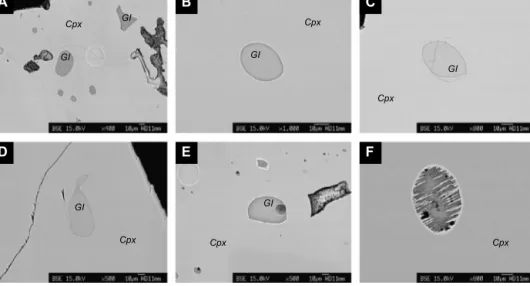
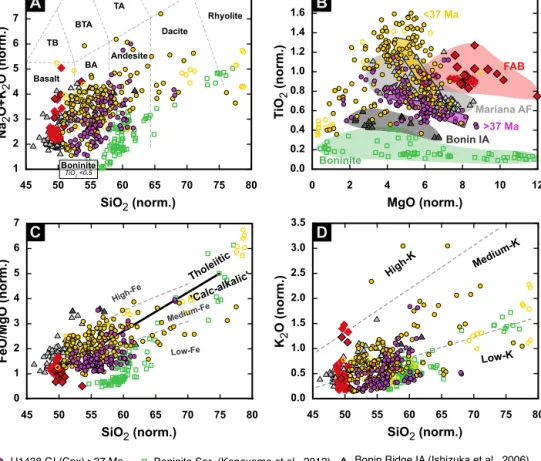
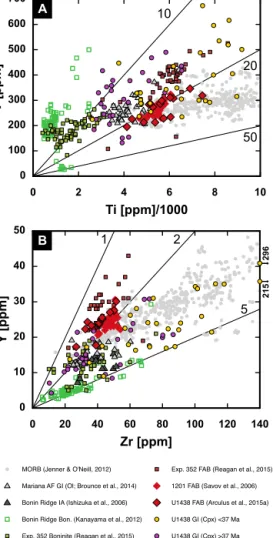
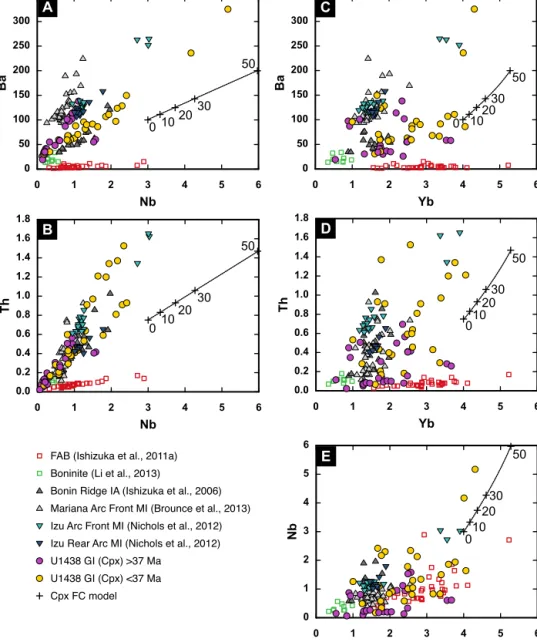

![Fig. 9. Age [Ma] plotted vs. Nb/Yb and deposition rate [m Ma − 1 ]. Also shown are major rifting/spreading events in the IBM and our interpretation of the long-term trends observed in Nb/Yb reflecting periods of decreased (“depletion”) or enhanced (“repleni](https://thumb-eu.123doks.com/thumbv2/1library_info/5326369.1680265/9.918.80.451.94.637/deposition-spreading-interpretation-observed-reflecting-decreased-depletion-enhanced.webp)
